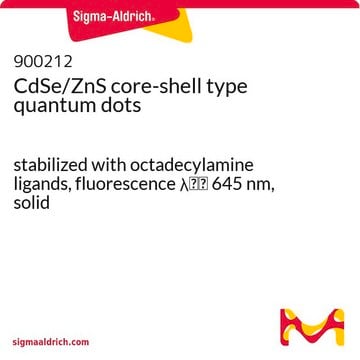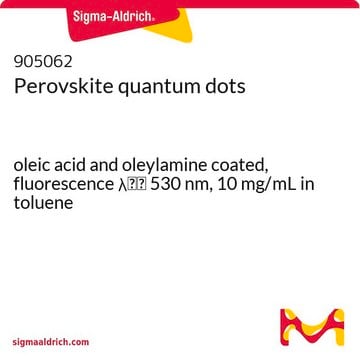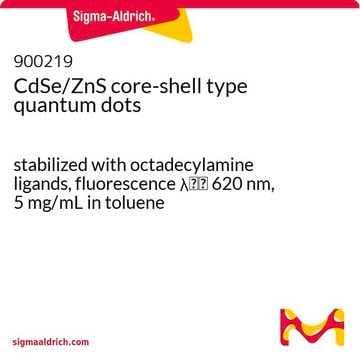The weight percentage of octylamine ligands compared to the quantum dots is not determined for this product.
790192
CdSe/ZnS core-shell type quantum dots
stabilized with octadecylamine ligands, fluorescence λem 620 nm, solid
Sinonimo/i:
Artificial atoms, Fluorescent nanocrystals, QDs
Scegli un formato
Scegli un formato
About This Item
Prodotti consigliati
Cerchi prodotti simili? Visita Guida al confronto tra prodotti
Categorie correlate
Applicazioni
Protocol to make QD solutions (dispersing QDs into solutions):
1. Weigh desired amount of the quantum dot powder and put it in a glass vial;
2. Add desired amount of the solvent, i.e. toluene, chloroform, hexane, etc. (mostly non-polar organic solvents) in the vial and shake the vial;
3. If there is any solid left in the vial after shaking, sonicate the vial for 30~60 seconds to get the quantum dot powder well dispersed. If required dilute the solution further.
Material has a shelf life of around 3 years if stored properly. Store at room temperature (4-25 °C); do not freeze. Should not be exposed to extreme temperatures.
Note legali
Avvertenze
Danger
Indicazioni di pericolo
Consigli di prudenza
Classi di pericolo
Acute Tox. 4 Inhalation - Acute Tox. 4 Oral - Aquatic Acute 1 - Aquatic Chronic 1 - Eye Dam. 1 - Skin Irrit. 2 - STOT RE 2 - STOT RE 2 Oral
Organi bersaglio
Kidney,Bone, Liver,Gastrointestinal tract,Immune system
Rischi supp
Codice della classe di stoccaggio
11 - Combustible Solids
Classe di pericolosità dell'acqua (WGK)
WGK 3
Punto d’infiammabilità (°F)
Not applicable
Punto d’infiammabilità (°C)
Not applicable
Elenchi normativi
Forniamo informazioni su eventuali restrizioni prevalentemente per i prodotti chimici. Per altre tipologie di prodotto siamo in grado di fornire soltanto informazioni limitate. Nessuna segnalazione significa che nessuno dei componenti è citato in un elenco. È dovere dell’utilizzatore assicurarsi che il prodotto venga impiegato in maniera sicura e a norme di legge.
EU REACH Annex XVII (Restriction List)
Scegli una delle versioni più recenti:
Possiedi già questo prodotto?
I documenti relativi ai prodotti acquistati recentemente sono disponibili nell’Archivio dei documenti.
I clienti hanno visto anche
Articoli
Quantum dots are tiny particles or nanocrystals of a semiconducting material with diameters in the range of 2-10 nanometers.
Dye-sensitized solar cells as a promising, low-cost photovoltaic technology.
Professor Sharma and colleagues review the synthesis and applications of this novel material. This includes a discussion of the unique properties of quantum dots and their suitability for solar cell applications, along with common synthesis techniques used to develop these materials.
Professor Xiaohu Gao (University of Washington, USA) provides a overview of recent quantum dot (QD) advancements and their potential for advancing bioassay and bioimaging technologies.
-
Wonder what is the percentage of weight is the octylamine ligands compared to the QDs?
1 risposta-
Utile?
-
-
What is the particle density for product 790192, CdSe/ZnS core-shell quantum dots?
1 risposta-
The particle density is not determined for this product.
Utile?
-
-
What is the molecular weight of CdSe/ZnS core-shell type quantum dots, and what is the recommended method for their dissolution?
1 risposta-
The molecular weight information for CdSe/ZnS core-shell type quantum dots is typically not provided in the QD field, as it can be calculated based on the quantum effect via size. The recommended solvents for dissolving CdSe/ZnS core-shell type quantum dots include chloroform, toluene, xylene, and THF. The procedure for dissolution involves adding the solvent to the QD solid, shaking it for 3 minutes, and sonication for 20 seconds if the QDs are not completely dispersed. If toluene is the solvent, any grade of toluene can be used. No specific equipment is needed for dissolving CdSe/ZnS core-shell type quantum dots; shaking the vial is sufficient.
Utile?
-
-
What is the Department of Transportation shipping information for this product?
1 risposta-
Transportation information can be found in Section 14 of the product's (M)SDS.To access the shipping information for this material, use the link on the product detail page for the product.
Utile?
-
-
What is the particle size and shell size for product 790192, CdSe/ZnS core-shell quantum dots?
1 risposta-
The particle size of the core and shell is about 8 nm and that of the surface ligand is 2 nm.
Utile?
-
Filtri attivi
Il team dei nostri ricercatori vanta grande esperienza in tutte le aree della ricerca quali Life Science, scienza dei materiali, sintesi chimica, cromatografia, discipline analitiche, ecc..
Contatta l'Assistenza Tecnica.


![(Ir[dF(CF3)ppy]2(dtbpy))PF6](/deepweb/assets/sigmaaldrich/product/structures/982/913/02dd8ddd-6deb-40a0-ab9b-07b18f1abb09/640/02dd8ddd-6deb-40a0-ab9b-07b18f1abb09.png)










